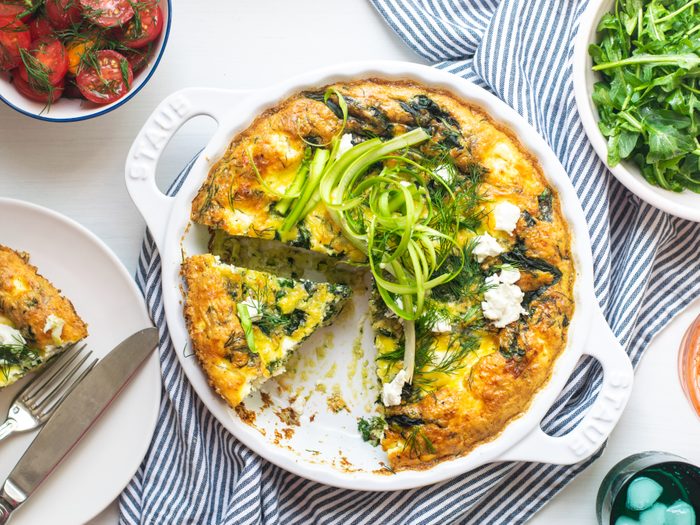The Nutritious Food We Love at Any Time of Day

A frittata is whatever you want it to be: breakfast on the go, a quick weeknight meal or a make-ahead brunch dish to serve a crowd. If you’re looking for a nourishing anytime meal full of veggies, frittatas are the answer.
Unlike their crusted cousin, the quiche, frittatas are made up primarily of eggs, a win because eggs are nutritional gold. Not only do they work magic in the kitchen by emulsifying dressings and whipping into airy meringues, but the unique nutritional profile of eggs makes them incredibly satisfying, no matter the time of day.
Eggs contain many important nutrients, in both the yolks and the whites. About two-thirds of eggs’ high-quality protein is found in the whites, while the yolks contain omega-3 fatty acids, vitamins A, E and B12, iron and a bit of protein. While eggs (especially yolks) have been demonized in the past for their cholesterol content, they’re now recognized as a healthy source of unsaturated fat and antioxidants. In fact, eggs seem to have no significant impact on your cholesterol levels at all. Egg yolks are also one of the few food sources that naturally contain vitamin D, which is linked to immunity and bone health.
Consuming a solid amount of protein at each meal has been shown to have beneficial effects in both the short and long term. In the hours after your meal, protein will keep you feeling more satisfied and full for longer. When you eat, your stomach stretches to accommodate food. Protein lowers your level of ghrelin, otherwise known as the hunger hormone, while boosting peptide YY, a hormone that makes you feel full. This elongates your satiety period, keeping hunger at bay. Protein also slows the digestion of carbohydrates, which has a small steadying effect on blood sugar, so you may be able to avoid bouts of low energy later in the day. Studies suggest that, over longer periods, sufficient protein may help maintain muscle mass, which tends to decrease rapidly as you age. Keeping your protein intake up, in combination with weight-bearing activity, will help you maintain muscle and stay strong over time—an egg-cellent bonus.
If you’re wondering how to get more eggs into your diet, a frittata is the perfect place to start. To further up the nutrition factor, strategically select your add-ins. Vitamin C-rich vegetables like spinach, kale and bell peppers are a great way to sneak in more greens and fibre to your meal. I love having a slice of frittata for lunch during the week with a side salad to round out my meal, but you could also cut it into squares and use it in place of fried or scrambled eggs in a breakfast sandwich to power your morning.
Optimal frittata additions include cured meats like bacon and chorizo and vegetables that don’t have a ton of water—save tomatoes and zucchini for another dish. To combat liquid seeping out, and to add flavour, always cook vegetables before adding them, so most of their liquid cooks off before they hit the oven. Cooked starchy leftovers, like that potato hash from brunch, also make great add-ins. If you have the patience, take the time to chop vegetables into smaller pieces: Large chunks can impact the structure of the frittata and cause it to crumble apart once you cut into it. Lastly, in my humble opinion, a frittata is incomplete without cheese. Hard cheeses that melt well, like cheddar, gruyere or fontina are good choices, but my go-tos are dollops of ricotta, goat’s cheese or crumbled feta for little pockets of melted cheesy goodness spread throughout.
A boiled egg makes for a nutritious midday snack, or better yet, go for a slice of veg-packed frittata. Eggs have what it takes to keep you well-fuelled all day long, especially when paired with all-star add-ins.
Next: A Leek, Dill and Goat Cheese Frittata That’s Perfect to Eat for Every Meal




